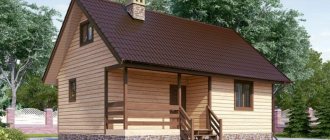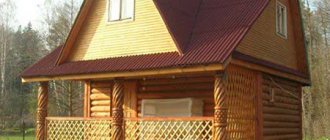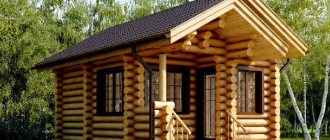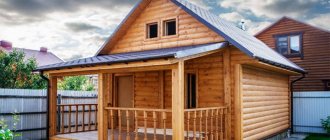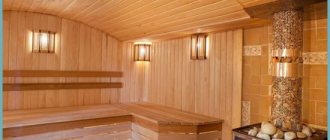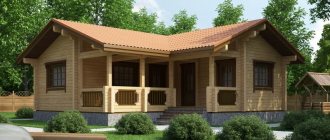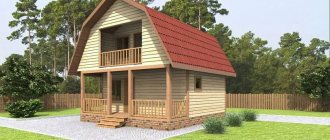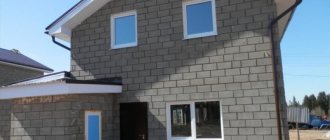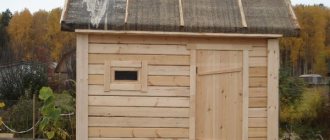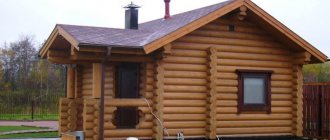Nothing can withstand time. Even traditional Russian baths. No, they have not gone away - they just began to use much cheaper materials, but with similar performance characteristics. Surely you have already heard positive reviews from the owners of bathhouses made of foam blocks more than once: people build them themselves and note their amazing practicality and savings in the invested material resources. True, in order to get a result that is truly pleasing to the eye and heart, it is necessary to take into account all the details of the layout and draw up a high-quality project. We save your time and present in this material the best projects for building a bathhouse from foam blocks with your own hands.
Advantages and disadvantages
There is an opinion that the main advantage of foam blocks as a material for construction is their exceptional low cost. Is this true or is it much more complicated? We’ll find out right now when we subject this material to a scrupulous analysis to identify obvious pros and cons.
Advantages
- high fire safety;
- fast construction;
- simple installation that does not require any special skills;
- very low cost;
- decent sound insulation;
- low thermal conductivity.
As you can see, foam blocks are not only available due to their low cost, but also impress with their impeccable fire safety and absolute ease of installation. Their closest competitor is expanded clay concrete blocks. It is no coincidence that DIY bathhouses made of expanded clay concrete are among the most popular projects. However, both some blocks and others have disadvantages. And they are very similar.
Flaws
- very low frost resistance;
- high water absorption;
- the material is exposed to fungus and rodents;
- average level of tightness.
Fortunately, these disadvantages are not critical, and the myths about the release of harmful substances into the air have long been successfully dispelled by experts.
In general, foam blocks are a completely reasonable solution for implementing a bathhouse project if you want to get by with a minimum investment. But you still have to take into account the costs of interior and exterior decoration, including insulation and waterproofing . This is the only way you can really enjoy a comfortable steam, and not shiver from the cold and complain about the rapidly falling temperature and dampness all around.
Finishing a block bath
The work on finishing the bath room includes:
- high-quality internal lining;
- exterior finishing.
Finishing activities indoors require fastening the sheathing, installing thermal insulation material, as well as protection with a vapor barrier membrane.
Finishing a bathhouse made of expanded clay concrete blocks
Various options for interior finishing are possible, which are attached to an insulated and vapor-insulated frame:
- wooden lining. It will saturate the room with a unique aroma during bath procedures;
- salt blocks. This is an original finishing option that has a beneficial effect on the respiratory system.
Exterior finishing activities include:
- Installation of external waterproofing.
- Fastening of thermal insulating ventilated panels.
- Installation of finishing.
Phased construction
Even a completely inexperienced person in this topic can build a bathhouse from foam blocks on their own. However, it is still necessary to find out the correct sequence of work - this will allow you to avoid frequent mistakes that people make out of ignorance. Therefore, pay attention to the step-by-step demonstration of the construction of such a bathhouse from foam blocks in our detailed instructions.
Construction of the foundation
- pour a bed of fine gravel and sand onto the prepared area and compact it with water, the optimal foundation depth is 30-40 centimeters;
- equip removable or monolithic formwork;
- reinforce the area with metal rods and pour the prepared concrete mixture, be sure to pierce the poured mass in several places to release the air that inevitably gets inside;
- cover the foundation with any waterproofing material and give it time to dry and harden (2-3 weeks), then cover it with roofing felt and proceed to the next stage of construction.
Walling
- make sure the foundation is even and start laying foam blocks: the first row is bonded with a traditional mortar based on sand and cement, it is very important to lay it out without deviations, so use a rubber hammer and a level to correct masonry errors;
- the bricks are not laid flat, as you might think at first, but on an edge;
- the second row is already fixed with a special glue, which is sold in any store, but you should not overdo it with the amount - a thin layer is enough;
- Be sure to lay a reinforcing mesh through every third row of the structure - this will make the walls much more durable and monolithic.
Erection of the roof
The photo below shows all the work on constructing the roof as part of the project for self-construction of a bathhouse from foam blocks.
Exterior finishing
To ensure that your foam block bathhouse does not lose its attractive appearance, be sure to take care of the finishing. Most often, siding , giving the building a beautiful and modern look.
However, there are many other options that may suit you much better. Take a look at what other materials are used for exterior finishing.
Insulation from the inside
Insulating the inside of foam block baths is a severe necessity, which is due to the very high water absorption of the material. High-quality work in this direction will help protect the walls from moisture penetration and fill the room with comfort. Which is very important if you are going to use the sauna not only in the summer. What can you take as insulation?
- mineral wool;
- glass wool;
- vapor barrier film;
- foil, etc.
Interior decoration
Here, as they say, everything is purely to your taste. Just don’t forget that you are building a bathhouse, which means that the material must withstand permanent exposure to high temperatures.
- lining;
- block house;
- tile;
- stone, etc.
The following video will tell you how to build a bathhouse using foam blocks. This is a fairly cursory, but very succinct and convincing story from a specialist competent in his field, who has built dozens of such objects with his own hands.
Types of material for block baths
You can build a bathhouse from blocks with your own hands using various types of building materials:
gas-filled concrete. It is the basis for the manufacture of blocks obtained as a result of a chemical reaction with the release of gas. It features a uniform distribution of air cells. Due to the varying degrees of pore concentration, it differs in density, ranging from 500 to 1000 kg/cm3. The thickness of the building material allows the construction of walls 20 cm thick, which is enough to maintain a comfortable temperature in the room; Types of building block material
ceramic blocks. In appearance they resemble traditional brick. They have increased moisture-resistant characteristics and provide a high level of thermal insulation. They are distinguished by the presence of air channels parallel to the height of the product. Mainly used for exterior decoration, rarely used for the construction of bathhouse walls due to the increased price. Inferior to brick in most characteristics; gas silicate products. The building material is produced by autoclave processing and contains lime. Gas silicate is externally easy to distinguish from other types of concrete products by its snow-white hue and regular geometric shape. The material intensively absorbs moisture, which negatively affects its integrity and strength characteristics. Its properties are inferior to aerated concrete and requires reliable waterproofing; foam concrete. It is a type of aerated concrete product. The manufacturing process involves the introduction of a foaming agent, which provides a porous structure. Available technology allows private production
When purchasing foam blocks made at home, pay attention to quality. For construction, it is convenient to use a foam block with dimensions of 60x20x30 cm; cinder blocks
Building materials, along with concrete, contain various types of slag, which are industrial waste. Cinder blocks are inexpensive compared to other varieties. They have an uneven surface, as well as significant dimensional deviations. You should not immediately use them for a block bath due to the release of harmful substances when heated. Before construction begins, the material must sit for a year; expanded clay concrete. Expanded clay granules made from baked clay are used as filler. Expanded clay concrete is characterized by reduced hygroscopicity and low weight. In terms of performance characteristics, it surpasses foamed concrete, as well as aerated blocks. Expanded clay concrete products have reduced dimensions compared to foam blocks and cinder blocks. Dimensions are 40x20x20 cm.
Types of building blocks blocks
Typical projects with photos and drawings
In order to choose a suitable project for a bathhouse made of foam blocks, you must first decide on the site that is at your disposal, as well as what you expect from your structure. Meticulous planning is a mandatory item in the “preparatory” program, but if you do not want to deal with the distribution of key zones, then use ready-made projects. They already provide for the separation of a sink and a steam room, and there is also an allocation of space for a relaxation room, a dressing room, and in some cases a veranda . Information on how many foam blocks are needed for a bath is in each size section.
3x3
How many foam blocks are needed: 134 pcs. (4.82 cubic meters)
Project options for those who want to build a compact bathhouse. Both separate washing and steam rooms are allowed, as well as combining two zones into one.
4x4
How many foam blocks are needed: 196 pcs. (7.06 cubic meters)
A selection of bathhouse projects with one of the most common sizes. The square base allows you to make good use of every centimeter of usable space.
3x4
How many foam blocks are needed: 172 pcs. (6.19 cubic meters)
A very viable rectangular and quite compact solution will undoubtedly appeal to those who do not have a reserve of square meters at their disposal.
6x4
How many foam blocks are needed: 245 pcs. (8.82 cubic meters)
An excellent selection of bathhouse projects that provide literally everything: a spacious dressing room, a relaxation room, and a veranda. The layout of bathhouses with an attic allows you to include in some cases a games room with a billiard table.
5x5
How many foam blocks are needed: 267 pcs. (9.61 cubic meters)
A project with the placement of functional areas for a spacious square bath.
6x6
How many foam blocks are needed: 334 pcs. (12.02 cubic meters)
How to make a vapor barrier on walls
Foam blocks absorb moisture very well, so installing a vapor barrier on the walls is mandatory. First, the foam blocks are treated with water-repellent compounds on the inside and outside. Then the insulation is attached inside. The best option is basalt or stone wool, as it does not absorb moisture well.
For mineral wool, a special frame is made from wooden beams impregnated with an antiseptic. The fastening step of the beams and their diameter depend on the size of the heat-insulating material; dowels are used as fasteners. Then the finishing finishing material, for example, lining or decorative facing slabs, is attached to the wooden frame.
The insulation is laid in 2 layers to avoid through joints. For vapor barrier, special film membranes are used, and the joints are covered with reflective tape. As additional vapor and thermal insulation, you can use foil penofol, securing it on top of the vapor barrier film.
